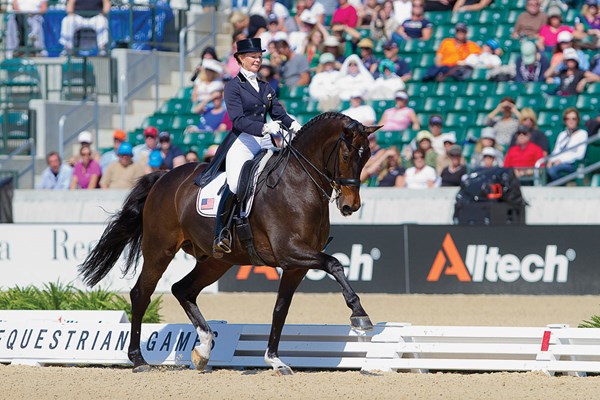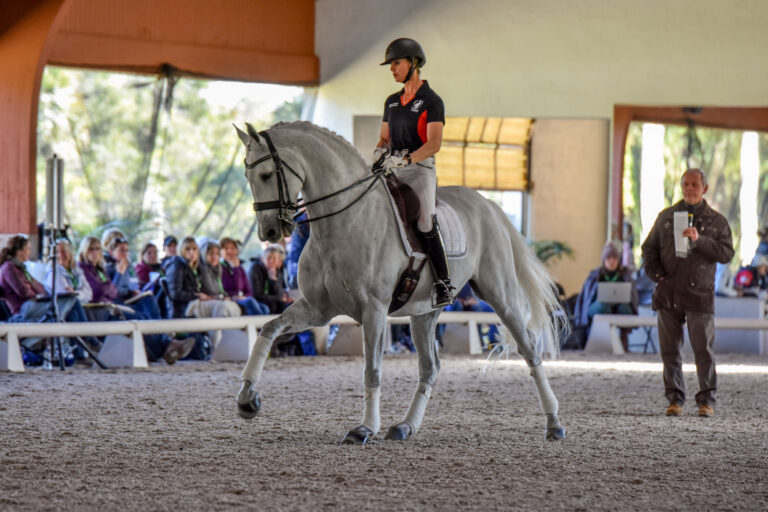It is not easy getting to know a horse that’s new to you, but we all have to do it eventually, whether it’s a new lesson horse you are riding or a new purchase you hope to show. Some horses are young and need to be started at the beginning. Some need retraining, and, if you are lucky, some are already well trained. In all these cases, a partnership needs to be formed.

Here is the story of how I got to know Nartan. Purchased by Jane Forbes Clark, Nartan was my 2010 Alltech/ FEI World Equestrian Games (WEG) partner and one of the most beautifully and correctly trained horses I have ever ridden.
Despite his height at 18 hands, Nartan was elegant, light and forward. He and I fit each other right from the start, but in the four months between my first rides on him and our arrival at the Kentucky Horse Park, I made a deliberate effort to establish a strong bond between us. Here are some insights into how our partnership got off to a good start and how you can do the same with your new horse.
Making Adjustments
With the pressure of international competition looming on a short time frame, I packed my bags in the summer of 2010 and moved to Holland, where Nartan lived at the time. This decision allowed me to train with top international Dutch rider Jeannette Haazen, who had owned, trained and ridden Nartan from the time he was 3 years old. Jeannette and Nartan had just been named champions of the 2010 Dutch indoor series and then won the Grand Prix Kür at the 2010 CDI Hagen.
The plan was to maintain his routine and his environment as we prepared for the WEG. From the start, I took responsibility for making most of the adjustments myself. Instead of having him adapt to me, I changed to fit him. The small adjustments we made to adapt to each other contributed to our success in Kentucky and as we went on to compete around the world in 2011.
I worked my way into Nartan’s routine, grooming him and tacking him up in the same manner that he had been used to for 12 years. I would lead him down the same quaint little lane every day to the arena. In the afternoons, I’d hand-graze him. We even shipped him to shows in the same truck that he had traveled in all his life.
While the idea was to minimize change for the horse, there were some things Nartan had to adjust to from the start. For instance, there was nothing I could do about my height. At 5 feet, 8 inches, I am a full five inches taller than Jeanette, the only person who had ever schooled him.
When I got the ride on this incredible horse, I did a lot of homework, studying how he had been trained and ridden. I watched countless videos of Jeannette riding him. She was very generous with her time and was insightful in transitioning Nartan to a new rider. I asked her every question I could think of about how she trained him, how she prepared for competition and how he reacted in various situations— warm weather, cold weather, rain and at horse shows.
In addition to riding him for 45 minutes six days a week, I studied Nartan in the barn. Just being with a horse is a big part of the experience for me. I talk to my horses a lot. Every morning I’d call Nartan’s name and greet him with an apple. I wanted him to recognize my voice and have a happy association with hearing it. Later on, if I ever needed to rely on my voice to calm him down, this connection would help in a stressful situation.
By grooming a horse, you can learn a lot, such as how skin-sensitive he is, which relates to how reactive he will be to your aids under saddle. So I spent hours every day grooming Nartan, picking out his stall and spending time with him so we could get to know each other. One day I was hand-walking him down the lane and a herd of cows charged up to the fence. I didn’t know how he would react. He did get on his toes a little, but he didn’t react very strongly to the antics of the cows. The fact that he maintained his composure during this “test” made a big impression on me and went a long way toward my trust in his reactions.
Ride with a Purpose
Every time I got on Nartan, in the beginning and even later on, I had a plan for what I wanted to accomplish. For instance, one of the many things Jeannette taught me was the importance of spending time on lateral work at the walk at the beginning of each ride. Nartan has done this every working day of his life. You can’t ride a real half halt until your horse is reactive to your aids. So this exercise helped me get Nartan working off my aids with the reactions that I wanted. When we first started working together, adding this to my list of daily goals was a good way to keep him supple, and it gave me the chance to work on something familiar to him. For me, creating goals was a great way to maximize our progress.
For anyone working with a new horse, this warm-up is great because there’s no speed involved and it makes the horse concentrate on you even if he’s checking out a new environment. You can repeat it over and over again and it won’t be upsetting to the horse. I’ve integrated this practice into my work with all my horses and students.
Practice your warm-up like this:
1. Go large in the arena, walking on a long rein for 10 minutes. Walk around without contact, but be ready to gather up the reins if you need to. As you get to know your horse better, spend as long as it takes for him to feel relaxed and pay attention.
2. Track right, pick up the reins and practice shoulder-in all the way down the long side. This will help your horse to stretch, work off your aids and pay attention to you. Take your time; don’t rush to get to work. Notice how your horse is feeling.
3. As you head into the first corner, practice walk–halt transitions. Make sure your horse is stretching through the bridle. Practice a few more walk–halt–walk transitions around the short side. Don’t worry about the collected frame yet. This is a great opportunity to practice your halts, which most people don’t practice enough.
4. As you walk on to the long side, do a haunches-in and focus on having your horse stretch through his body. If you have mirrors, check to make sure he’s bent correctly. Think of this as the beginning of the half pass, which is something a lot of people get wrong. Breaking it down at the walk, you can pick it apart and make sure that the horse is truly bent around your inside leg and working off your outside leg.
5. Repeat the walk–halt–walk transitions on the other end of the arena.
Taking your time at the walk is never a waste. I do this series a few times at the beginning of each riding session until I feel that the horse is really stretching and moving off the aids. For horses working at the upper levels, I might add a few transitions within the gaits or half passes at the walk in each direction. I especially love practicing the half pass at the walk with my Grand Prix horses because it is much less stress on their bodies than the trot half pass. I can also make corrections more easily at the walk and the horse has less work to do at the trot.
For people riding at the lower levels, this is a great exercise to help figure out your new horse’s reactions to your aids. Does your horse react enough? Does he over-react? Don’t move on from these walking exercises until you get the reactions you want—make that your goal every day. I don’t push past the warm-up stage until I feel like the horse is waiting for me in the bridle, or until I feel like he’s under control and riding nice half halts. Once he’s reacting the way I want him to, then I can move on to the next phase of work.
By the time Nartan and I reached Kentucky for the WEG, we’d done a lot together in a short period of time: Four Grand Prix tests in Holland and France and the WEG trials at the Festival of Champions in Gladstone, New Jersey. After we made the U.S. team for the WEG, we did tests every week in training camp. By the time we got to Kentucky, our partnership was established. This made me happy. I was riding in the same bit and bridle that Jeannette had ridden Nartan in for years, but for the first time, I felt like he was really my ride. We were prepared and confident.
Katherine Bateson-Chandler is British by birth but moved to the United States in the mid-1980s. At 17 years old, she began grooming for six-time Olympian Robert Dover, going with him to two World Championships and two Olympic Games. She worked her way up in Dover’s stable and competed in her first Grand Prix test in 2005.











